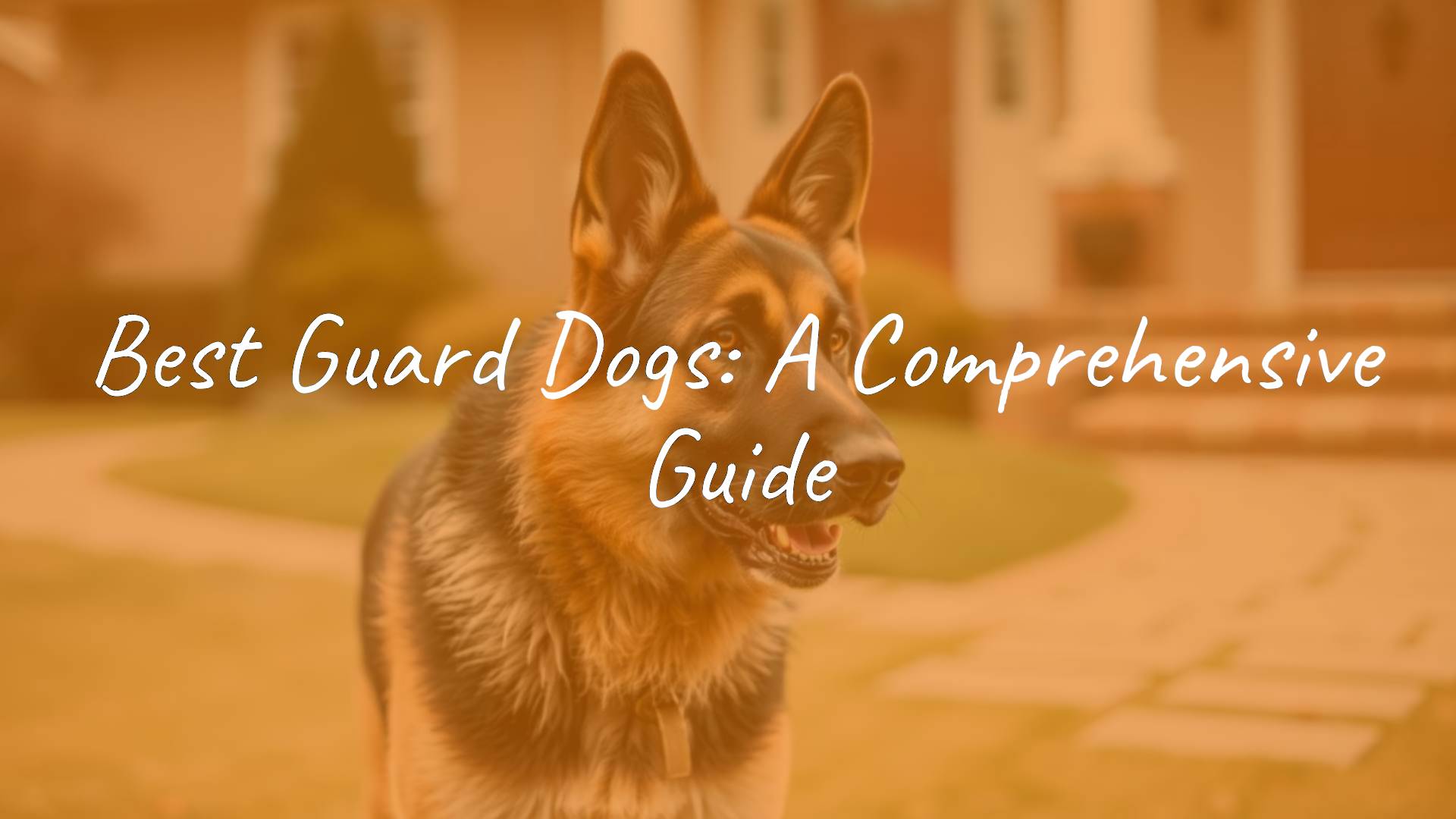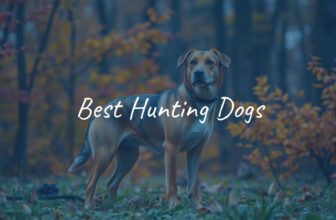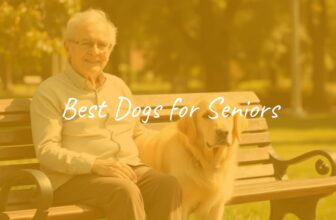
To protect your home and family, asking which breed makes the “best guard dog” is natural. There isn’t one perfect breed. Good results come from natural traits, steady training, and a strong bond with the owner. Top guard dogs are smart, loyal, and protective. They warn you about trouble and, if needed, stand as a strong barrier or protector.
These dogs do more than act like a living alarm; they become part of the family and bring peace of mind. Picking the right guard dog means learning their traits, committing to training and social time, and accepting the real duty that comes with a capable dog. Let’s look at canine guardians to see what makes a dog succeed in this role.

What Makes a Good Guard Dog?
A good guard dog comes from the right mix of instinct and training. It’s not simply about size or a loud bark; it’s about built-in qualities shaped with guidance to create a watchful, polite protector. These dogs have a natural drive to defend their home and family.
They work well because they combine physical power with a sharp mind. This lets them judge situations and act the right way. Their first job is to deter and alert, but what sets them apart is the ability to step in when a real threat appears.
Key Traits of Effective Guard Dogs
Guardian breeds share several key traits that help them do the job well. Loyalty comes first; a dog’s devotion to its family is the base of its protective drive. They are brave, stand their ground, and have the strength to scare off intruders. Watchfulness also matters a lot; they notice changes fast and warn their owners.
- Loyalty and family bond
- Courage and confidence
- Strength and presence
- Watchfulness and quick alerts
- Intelligence to tell real threats from normal life
- Steady, self-assured temperament
- Territorial drive to guard home and yard
Intelligence is key. A smart guard dog can tell a true danger from a harmless event, which helps avoid needless aggression. Their temperament should be calm, confident, and firm but manageable with training. Territorial instincts also help, as they see their home and family as something to protect.
Guard Dogs vs. Protection Dogs: Important Differences
People often mix up “guard dog” and “protection dog,” but they are not the same. Guard dogs are great at watching and warning. They deter intruders with their presence, strong bark, and alert attitude, telling owners when someone is near or something feels wrong. Their job is mostly to discourage threats.
| Type | Main Role | Training Level | Typical Action | Best For |
|---|---|---|---|---|
| Guard Dog | Watch, deter, alert | Basic to intermediate | Bark, stand presence | Property security |
| Protection Dog | Defend people on command | Advanced, specialized | Engage if needed | Personal defense |
Protection dogs get special training to defend their owners in risky moments. They learn to act if a threat happens and may engage if needed. Breeds like German Shepherds and Belgian Malinois often do this work. Your choice depends on your needs: guard dogs focus on property and alerts, while protection dogs are aimed at direct personal defense.
Family-Friendly Guard Dogs: Are They Possible?
Yes. The idea that a guard dog can’t be a loving family pet is a myth. Many strong guard breeds are also gentle and bond closely with their people. The trick is picking breeds that balance alertness with affection. These dogs are confident and steady, building strong bonds with family members.
With early training and good social time, many guard breeds live well with small children, other dogs, and even other pets. They should be protective by nature yet gentle at home. Breeds like the Australian Shepherd are playful and watchful, get along with kids, and give both company and protection, making them a strong pick for families.

Popular Guard Dog Breeds and Their Characteristics
Guard dogs vary widely, and each breed brings its own skills and personality to the job. From shepherds to mastiffs, many have been shaped over generations to watch and protect.
Knowing the key traits of popular guard dog breeds helps anyone thinking about adding one to the family. This knowledge helps you match a dog’s built-in abilities and needs with your lifestyle and security goals.
German Shepherd
The German Shepherd is often linked with the idea of a guard dog. They are among the smartest breeds, known for intelligence, loyalty, and range of skills. First bred to herd sheep, their sharp minds and protective drive led to police, military, search and rescue, and detection work.
German Shepherds are confident and form strong bonds, often guarding other pets too. They train well and like to please, making them tough protectors and caring companions. They are active and need plenty of exercise and mental work to stay happy.
Doberman Pinscher
Dobermans are fast, brave, and very loyal. Bred for personal protection, they still work in security and police roles due to alertness, agility, strength, and courage. With the right social time, they can be calm and loving family dogs.
Dobermans bond closely with their people. They need regular exercise and mental challenges. Their sleek, muscular look gives a strong presence, and they are both strong protectors and elegant companions.
Rottweiler
Rottweilers are large and muscular with a distinct coat pattern, giving them a strong presence. They love and watch over their families, yet stay cautious with strangers. They sometimes get a tough reputation, which can help as a visual deterrent if you want protection.
With early training and social time, plus a clear leader at home, Rottweilers are usually calm and relaxed, and they can play well with other pets and kids. They are very loyal and also serve as guide dogs, police dogs, and search and rescue dogs.

Bullmastiff
Calm at home and bold on the job, the Bullmastiff is a large, muscular guardian with strong protective instincts, great strength, and steady loyalty. English gamekeepers in the mid-1800s developed them to catch poachers, using size to pin suspects rather than bite.
Bullmastiffs are gentle giants. They are smart and willing to please, so they train well, though they can be stubborn at times. With good social time and guidance, they make warm companions and sharp protectors, keeping families safe while staying friendly.
Belgian Malinois
Belgian Malinois often serve in military and police roles thanks to high intelligence and agility. They love to work and can learn almost anything. They are very loyal to family and will defend them without hesitation. They also adapt well, mix with other dogs and people, and travel easily, which suits active homes.
They are energetic and need lots of mental work and regular exercise. With training, Malinois become loving family pets and strong guard dogs, known for steady dedication and a protective mindset.
Cane Corso
The Cane Corso is a loyal, powerful dog, often over 100 pounds. Its history goes back to Roman times, and its name means “bodyguard dog” in Latin. These smart, trainable, confident dogs once guarded homes, hunted, and even fought.
Cane Corsos are bold and loyal but may be cautious with strangers and other animals. They need an experienced owner and plenty of social time and training. Their size means they may not fit well with very small children. Regular exercise and ongoing social time are very important for good behavior and health.
Akita
The Akita is a large, strong, double-coated dog from Japan, known for dignity, loyalty, and strong protective instincts. They are very smart and independent, forming deep bonds with family while staying wary with strangers. They have a past in hunting, personal protection, and military work.
Because they can be stubborn and independent, they are not ideal for first-time owners. Early training and lots of social time help them live safely with other pets and kids and prevent unwanted behavior. While aloof with some people, they are deeply loyal to those they trust.
Giant Schnauzer
Giant Schnauzers are powerful, smart, and very territorial. Bred in the German Alps, they make strong guardians. They bark loudly to warn of danger and stay tuned to their owners’ needs. Their bravery and loyalty add security, and their intelligence supports obedience and protection training.
They are affectionate and need plenty of attention, plus lots of physical and mental activity. They do best in homes with structure and regular engagement. They can be gentle with small children yet scary enough to make intruders think twice, which makes them strong family guard dogs.
Great Dane
Called the “Apollo of Dogs,” the Great Dane stands out for size, alertness, and a gentle but protective nature. Though friendly, they have a natural drive to protect family and territory. Their height alone can scare off intruders.
Great Danes are playful and loving and enjoy family life. They are patient with young kids. They stay aware of their surroundings and warn owners of odd activity. Their size and sharp awareness make them very good watchdogs without needing to be aggressive.
Boerboel
The Boerboel is a very large, strong working dog from South Africa, bred to guard homesteads in tough conditions. They are intensely loyal and will stand up for their family, even at great risk, if they sense danger. Boerboels are independent but need plenty of attention.
They are loving with children and loyal but can be stubborn. Early training and firm guidance matter a lot with this breed, since their size and willpower can challenge new owners. A healthy Boerboel, 64-70 cm tall and 70-90 kg in weight, is a serious and devoted guardian.
Other Excellent Guard Dog Breeds
Beyond these well-known breeds, many others can guard well and bring their own strengths. The Anatolian Shepherd Dog is a tough, impressive flock guardian with a protective nature. The Beauceron is powerful, sharp, spirited, and versatile. The Bouvier des Flandres is a sturdy, broad-chested, tousle-coated dog with strong guarding skills.
Also consider the Briard, loyal and spirited; the Komondor, with its corded coat and natural caution with strangers; the Rhodesian Ridgeback, once used to hunt lions and known for facing intruders; and the Staffordshire Bull Terrier, a loyal, smart, protective dog with a sweet nature when well-socialized. With good training and social time, these breeds can give both security and friendship.
How to Choose the Best Guard Dog for Your Home
Picking the right guard dog is not a single answer for everyone. It needs careful thought about your home, family, and lifestyle. The “best” dog for one home might be wrong for another.
Look for a dog whose instincts, size, energy, and temperament match what you can handle and provide. This careful match helps you live well together and get the protection you want.
Consider Your Living Space and Lifestyle Needs
Your home and daily routine are key in choosing a breed. Big, active breeds like Belgian Shepherds or German Shepherds need plenty of room and regular, hard exercise. They do best where they can move and think every day. If you live in an apartment or have a small yard, a Great Pyrenees may not be the right fit, even if calm indoors.
Some breeds with guarding traits can adapt to smaller spaces if their exercise and mental needs are met. A Boxer can do well in a small home with enough activity. Think about how much time you can give to walks, play, and training. Active breeds need active owners to avoid boredom and behavior problems.
Guard Dogs for Families with Children
If kids live at home, choosing a guard dog needs extra care. You want a dog that protects but is also gentle, patient, and tolerant. Australian Shepherds often work well for families because they are playful and watchful. Great Danes are patient with young children, even with their big size.
Remember, early social time and steady training matter for any dog living with kids. Teach children to treat the dog with respect. Some breeds need closer management around very young kids due to size or intensity, like the Cane Corso, which may not suit families with small children without strong experience and training.
Guard Dogs for Apartments or Small Spaces
Apartment living does not mean you must miss out on a guard dog. While many guard breeds are big, some can do well in smaller homes if their exercise and mental needs are met. For example, the Chow Chow can be content in apartments or townhouses with a daily walk.
Pick a breed with moderate energy or one that can meet exercise needs through planned walks and indoor play. Some small dogs are excellent watchdogs and will alert you to visitors or odd sounds. The main goal is to give enough physical and mental activity to avoid boredom and damage at home.
Guard Dogs for Large Properties or Farms
For large properties, farms, or wide outdoor areas, some breeds are a very good fit. They often have strong territorial instincts and a history of working on their own to guard livestock or land. The Anatolian Shepherd Dog and the Great Pyrenees were bred as flock guardians, making them well suited to covering big spaces and keeping predators away.
Rhodesian Ridgebacks also enjoy room to patrol. These breeds have the stamina to cover large areas, and their size and presence are strong deterrents. While they can work on their own, they still need training and a close bond with their owners to learn their role and limits on the property.

What to Consider Before Getting a Guard Dog
Bringing a guard dog into your life is a big commitment, far beyond picking a breed. It calls for a full understanding of the dog’s needs, the cost, and the time needed to raise a steady, effective guardian.
Thinking through these points before you welcome a guard dog will help you and your dog have a good experience.
Time Commitment and Exercise Requirements
Many guard breeds, especially larger and smarter ones, need a large time investment. This goes beyond feeding and short walks. It includes steady training, plenty of exercise, and planned social time. Breeds like German Shepherds, Dobermans, and Belgian Malinois are active and enjoy both mental and physical challenges.
They need daily activities beyond a quick stroll. Plan for long walks, jogs, structured play, or dog sports. Without enough outlets, these smart dogs can get bored and develop bad habits. Owners should be ready to put time into obedience training and ongoing activities to keep their dogs happy, healthy, and polite.
Health Issues Common in Guard Dog Breeds
Like all dogs, guard breeds face some health risks. Their size, strength, and very watchful nature can play a part. Large breeds such as German Shepherds, Rottweilers, and Great Danes can develop hip and elbow dysplasia. Bullmastiffs, according to the Petsure Pet Health Monitor 2025, have higher risk of Lymphoma (cancer), and Dobermans can face a blood clotting disorder.
High alertness and territorial behavior can raise stress, which may affect the immune system and raise the risk of stomach issues, anxiety, and heart strain. Regular vet checkups help with early detection and care. If you know these risks, you can plan care early and support long-term health.
Costs of Care, Training, and Upkeep
Owning a guard dog can be expensive. Larger, powerful dogs eat more, need bigger crates, and may have higher vet costs than small breeds. Buying a well-bred puppy from a reputable breeder can also cost more because of lineage and health checks.
After purchase, plan for ongoing costs: quality food for size and activity, routine vet care with shots and preventive treatments, and possible emergency care. Professional training, especially for advanced protection work, can add up. Grooming for thick-coated breeds like the Akita or Komondor costs more too. Plan for these costs so you can give your dog a good life from start to finish.
Training and Socialization for Guard Dogs
The safety and success of a guard dog depend mostly on good training and wide social time. Natural protective instincts help, but without guidance they can become unpredictable or too intense. The goal is to guide these instincts into a steady, thoughtful guardian.
This process turns a powerful animal into a polite companion that knows when to watch and when to relax, and can tell a real threat from daily life.
Why Early Training Matters
Early training is very important for guard breeds. Start in puppyhood with obedience to build good habits. Basic commands like “sit,” “stay,” and “come” give control and clear communication. Early social time exposes the puppy to many people, places, sounds, and animals in a positive way.
This helps them grow into balanced adults and learn the difference between normal situations and true threats. Without early and steady social time, even gentle breeds can become fearful or too reactive. For breeds like the Akita or Cane Corso that may be reserved with strangers, early and ongoing social time is very important to manage their protective side and build confidence without aggression.
Professional Training for Home Security
While many owners can handle basic obedience and social time, professional training can be very helpful, especially if you want a dog for home security or personal protection. Trainers can teach advanced skills like patrolling a yard, spotting real threats, and responding the right way without extra aggression. They also show owners how to reinforce good habits and fix unwanted ones.
This training helps shape the dog’s protective instincts so it can act quickly and with good judgment. Protection work is even more intense, with controlled defense skills. A pro can also help build a strong bond between owner and dog, so the dog sees its owner as the leader and trusts their decisions.

Balancing Protective Instincts and Social Behavior
One tricky part of raising a guard dog is balancing protective drive with safe social behavior. You want a dog that warns you and scares off intruders, but also one that acts calm with invited guests, kids, and other pets. You get this balance with steady training and constant social time throughout life.
The aim is a reliable protector and a polite companion. Teach the dog when it is “on duty” and when to relax. Use positive rewards to build good habits. Clear rules and steady leadership help prevent overprotectiveness or needless aggression. For breeds like the Rottweiler, this balance is especially important so they stay loving family members, not a risk.
Benefits and Risks of Owning a Guard Dog
Choosing a guard dog has many sides. It brings clear benefits in safety and company, and it also brings special challenges and duties. Knowing both sides helps you decide wisely.
A guard dog can be a great asset, but only if the owner is ready for the commitment.
Advantages for Home Security and Family Safety
The biggest benefit of a guard dog is a greater sense of home safety. A large, imposing breed is a strong deterrent to intruders. Many will alert owners by barking at odd activity, giving you time to react and often scaring away threats before they grow. This active defense can work better than passive systems.
Beyond scaring off trouble, their loyalty and protective drive mean many will defend family if needed. This gives peace of mind, knowing a watchful, devoted companion is always on duty. The bond you build also enriches family life with love, company, and shared purpose.
Potential Challenges and Owner Responsibilities
Guard dogs also bring challenges. Their strength and size call for an owner who can guide and control them. Without proper training and social time, they can become unpredictable, too aggressive, or unsafe, which can lead to legal issues and stress.
They often need lots of exercise and mental work, which requires time. Health issues in large breeds can add high vet costs. Some dogs may be reactive if not managed well, leading to injuries or behavior problems. Owners must commit to lifelong care, steady training, and ongoing social time so their dog stays safe and well adjusted.
Legal and Insurance Considerations
Know your local laws about certain breeds, especially those labeled “dangerous” or “aggressive.” Some places have breed rules that limit ownership, require permits, or require special insurance. Ignoring rules can bring penalties, forced rehoming, or worse.
Insurance matters too. Many home policies limit or exclude some breeds or charge higher premiums. Check with your insurer so you have enough liability coverage in case of an incident. Being informed on laws and insurance is part of responsible ownership.
Frequently Asked Questions About Guard Dogs
As you learn about guard dogs, many questions may come up. Bringing a specialized companion into your life is a big step, and clear answers help you build a safe, successful partnership.
Here are common questions with guidance to help you move forward.
Which Guard Dog Breed Is Right for Me?
The “right” breed depends on your situation. There is no single best. Look for a match with your lifestyle, home, and experience. Do you have a yard or live in an apartment? How active are you, and how much time can you give to exercise and training? Do you have kids or other pets?
German Shepherds are very trainable and fit many roles, but they need lots of engagement. Rottweilers and Dobermans are strong and loyal but need experienced owners with firm guidance. If you want a dog that protects and is gentle with kids, an Australian Shepherd or a Great Dane might fit. Research breeds carefully, looking at guarding ability, temperament, energy, and needs, so the match works at home.
Can My Pet Become a Guard Dog?
Many pets, no matter the breed, have strong loyalty and can guard to a degree. Many dogs are very focused on giving love, company, and a sense of safety to their people. Even small breeds can be great watchdogs, warning you about strangers with a bark. Still, there is a difference between barking at the mail carrier and a dog trained to deter or stop a threat.
Some breeds are more inclined to guard, but any dog can learn basic alerting. The key is steady training and social time. A well-bonded dog that knows its role often becomes more protective. With the right balance of guarding and family life, many dogs bring both security and friendship, even without the size of classic guard breeds.
How can I keep my guard dog safe around others?
Keeping your guard dog safe around family, guests, and the public is very important and takes ongoing training and social time. Start early and keep going. This teaches good behavior in many places and with many people, so the dog learns the difference between normal life and real threats.
Beyond social time, set clear rules and keep obedience training steady. Your dog must follow commands every time so you have control. Professional training can sharpen these skills, teaching the dog to protect when needed and to stand down on command. Be a responsible owner: supervise your dog around strangers, watch closely with children, and use a leash in public. A well-trained, well-socialized guard dog is confident, balanced, and safe in the community.






